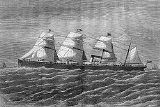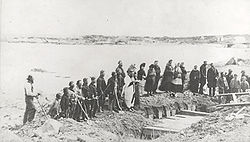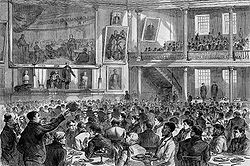
RMS Atlantic
Encyclopedia
RMS Atlantic was a transatlantic ocean liner
of the White Star Line
that operated between Liverpool
, United Kingdom
, and New York City
, United States
. During the ship's 19th voyage, on 1 April 1873, it ran onto rocks and sank off the coast of Nova Scotia
, killing 535 people. It remained the deadliest civilian maritime disaster in history until the sinking of the SS Norge
in 1904.
in Belfast
in 1870, and was the second ship built for the newly born White Star Line
. She was powered by a steam engine producing 600 horsepower driving a single propeller, along with four masts rigged for sail
. She sailed for New York on her maiden voyage on 8 June 1871.

 On 20 March 1873 the Atlantic departed on her 19th voyage from Liverpool with 952 people on board, of whom 835 were passengers. En route, the crew decided to make port at Halifax, Nova Scotia
On 20 March 1873 the Atlantic departed on her 19th voyage from Liverpool with 952 people on board, of whom 835 were passengers. En route, the crew decided to make port at Halifax, Nova Scotia
to replenish coal for the boilers.
During the approach to Halifax on the evening of March 31 the captain and 3rd officer were on the bridge until midnight, while the Atlantic made her way through a storm, proceeding at 12 knots (22 km/h) for the entrance of Halifax harbour, experiencing intermittent visibility and heavy seas. Unbeknownst to the crew or passengers, the Atlantic was approximately 12½ miles (20 km) off-course to the west of Halifax Harbour
. Officers failed to take soundings, post a masthead lookout, reduce speed or wake the captain as they approached the unfamiliar coast. They somehow did not spot the Sambro Lighthouse, the large landfall lighthouse which warns mariners of the rocky shoals to the west of the harbour entrance.
At 2:00 a.m. local time on 1 April 1873, the Atlantic struck an underwater rock called Marr's Head 50 metres from Meagher's Island, Nova Scotia. Lifeboat
s were lowered by the crew but were all washed away or smashed as the ship quickly filled with water and flipped on its side. Survivors were forced to swim or climb ropes first to a wave-swept rock and then to a barren shore. Residents of the tiny fishing village of Lower Prospect
and Terence Bay
soon arrived to rescue and shelter the survivors, but 535 people died, leaving only 371 survivors.. The ship's manifest indicates that of the 952 aboard, 156 were women and 189 were children on board (including two who had been born during the voyage). All women and all children perished except for one twelve-year-old boy, John Hindley. Ten crew members were lost, while 131 survived. This was the worst civilian loss of life in the Northern Atlantic until the wreck of Norge
on Rockall
on 28 June 1904. The Canadian government inquiry concluded with the statement, "the conduct of Captain Williams in the management of his ship during the twelve or fourteen hours preceding the disaster, was so gravely at variance with what ought to have been the conduct of a man placed in his responsible position".
A young doctor from Germany, Emil Christiansen, had been listed as dead in transcripts of the passenger lists sent to newspapers, but it appears he had survived. Apparently, Dr. Christiansen had survived the wreck with only a broken arm and left for the United States. It is believed that he did not speak very much English and did not know to report his status to the proper authorities. It is not known how he traveled to the United States, but it is known that he married in 1876 and had four children. A descendant of Dr. Christiansen had visited the SS Atlantic Heritage Park and Interpretation Centre and pointed out the error in the passenger list at the museum site. Also, the spelling of the name was different on the passenger list transcripts, possibly leading to some confusion; on various copies of the list, it had been sometimes spelled "Emile Christianson". Many names on the list were spelled phonetically resulting in the possibility of mistaken identities.
being first) but carried the notoriety of being the first White Star Line steamer to sink. (The company had previously lost the clipper RMS Tayleur
in Dublin Bay
in 1854). Other White Star Line ships lost in the North Atlantic include SS Naronic
, RMS Republic, and RMS Titanic.
Today, most of the ship lies heavily fragmented under 40 to 60 feet of water. Artifacts recovered from several salvage operations are on display at the Maritime Museum of the Atlantic
in Halifax, Nova Scotia and also at the SS Atlantic Heritage Park and Interpretation Center, in Terence Bay, Nova Scotia
. A monument to the wreck is located at the mass grave near the interpretation centre in the Terence Bay Anglican Cemetery, while a smaller monument marks a second mass grave at the Catholic cemetery.
Ocean liner
An ocean liner is a ship designed to transport people from one seaport to another along regular long-distance maritime routes according to a schedule. Liners may also carry cargo or mail, and may sometimes be used for other purposes .Cargo vessels running to a schedule are sometimes referred to as...
of the White Star Line
White Star Line
The Oceanic Steam Navigation Company or White Star Line of Boston Packets, more commonly known as the White Star Line, was a prominent British shipping company, today most famous for its ill-fated vessel, the RMS Titanic, and the World War I loss of Titanics sister ship Britannic...
that operated between Liverpool
Liverpool
Liverpool is a city and metropolitan borough of Merseyside, England, along the eastern side of the Mersey Estuary. It was founded as a borough in 1207 and was granted city status in 1880...
, United Kingdom
United Kingdom
The United Kingdom of Great Britain and Northern IrelandIn the United Kingdom and Dependencies, other languages have been officially recognised as legitimate autochthonous languages under the European Charter for Regional or Minority Languages...
, and New York City
New York City
New York is the most populous city in the United States and the center of the New York Metropolitan Area, one of the most populous metropolitan areas in the world. New York exerts a significant impact upon global commerce, finance, media, art, fashion, research, technology, education, and...
, United States
United States
The United States of America is a federal constitutional republic comprising fifty states and a federal district...
. During the ship's 19th voyage, on 1 April 1873, it ran onto rocks and sank off the coast of Nova Scotia
Nova Scotia
Nova Scotia is one of Canada's three Maritime provinces and is the most populous province in Atlantic Canada. The name of the province is Latin for "New Scotland," but "Nova Scotia" is the recognized, English-language name of the province. The provincial capital is Halifax. Nova Scotia is the...
, killing 535 people. It remained the deadliest civilian maritime disaster in history until the sinking of the SS Norge
SS Norge
SS Norge was a Danish passenger liner sailing from Copenhagen, Oslo and Kristiansand to New York, mainly with emigrants, which sank off Rockall in 1904 in the biggest civilian maritime disaster in the Atlantic Ocean up to that time....
in 1904.
History
The Atlantic was built by Harland and WolffHarland and Wolff
Harland and Wolff Heavy Industries is a Northern Irish heavy industrial company, specialising in shipbuilding and offshore construction, located in Belfast, Northern Ireland....
in Belfast
Belfast
Belfast is the capital of and largest city in Northern Ireland. By population, it is the 14th biggest city in the United Kingdom and second biggest on the island of Ireland . It is the seat of the devolved government and legislative Northern Ireland Assembly...
in 1870, and was the second ship built for the newly born White Star Line
White Star Line
The Oceanic Steam Navigation Company or White Star Line of Boston Packets, more commonly known as the White Star Line, was a prominent British shipping company, today most famous for its ill-fated vessel, the RMS Titanic, and the World War I loss of Titanics sister ship Britannic...
. She was powered by a steam engine producing 600 horsepower driving a single propeller, along with four masts rigged for sail
Sail
A sail is any type of surface intended to move a vessel, vehicle or rotor by being placed in a wind—in essence a propulsion wing. Sails are used in sailing.-History of sails:...
. She sailed for New York on her maiden voyage on 8 June 1871.
Disaster


City of Halifax
Halifax is a city in Canada, which was the capital of the province of Nova Scotia and shire town of Halifax County. It was the largest city in Atlantic Canada until it was amalgamated into Halifax Regional Municipality in 1996...
to replenish coal for the boilers.
During the approach to Halifax on the evening of March 31 the captain and 3rd officer were on the bridge until midnight, while the Atlantic made her way through a storm, proceeding at 12 knots (22 km/h) for the entrance of Halifax harbour, experiencing intermittent visibility and heavy seas. Unbeknownst to the crew or passengers, the Atlantic was approximately 12½ miles (20 km) off-course to the west of Halifax Harbour
Halifax Harbour
Halifax Harbour is a large natural harbour on the Atlantic coast of Nova Scotia, Canada, located in the Halifax Regional Municipality.-Harbour description:The harbour is called Jipugtug by the Mi'kmaq first nation, anglisized as Chebucto...
. Officers failed to take soundings, post a masthead lookout, reduce speed or wake the captain as they approached the unfamiliar coast. They somehow did not spot the Sambro Lighthouse, the large landfall lighthouse which warns mariners of the rocky shoals to the west of the harbour entrance.
At 2:00 a.m. local time on 1 April 1873, the Atlantic struck an underwater rock called Marr's Head 50 metres from Meagher's Island, Nova Scotia. Lifeboat
Lifeboat (shipboard)
A lifeboat is a small, rigid or inflatable watercraft carried for emergency evacuation in the event of a disaster aboard ship. In the military, a lifeboat may be referred to as a whaleboat, dinghy, or gig. The ship's tenders of cruise ships often double as lifeboats. Recreational sailors sometimes...
s were lowered by the crew but were all washed away or smashed as the ship quickly filled with water and flipped on its side. Survivors were forced to swim or climb ropes first to a wave-swept rock and then to a barren shore. Residents of the tiny fishing village of Lower Prospect
Terence Bay, Nova Scotia
Terence Bay is a rural fishing community on the Chebucto Peninsula in the Halifax Regional Municipality, Nova Scotia. It is located on the shore of the Atlantic Ocean, 10 km off the Prospect Road, off Route 333, 21.2 kilometers from Halifax.The community has the status of designated place in...
and Terence Bay
Terence Bay, Nova Scotia
Terence Bay is a rural fishing community on the Chebucto Peninsula in the Halifax Regional Municipality, Nova Scotia. It is located on the shore of the Atlantic Ocean, 10 km off the Prospect Road, off Route 333, 21.2 kilometers from Halifax.The community has the status of designated place in...
soon arrived to rescue and shelter the survivors, but 535 people died, leaving only 371 survivors.. The ship's manifest indicates that of the 952 aboard, 156 were women and 189 were children on board (including two who had been born during the voyage). All women and all children perished except for one twelve-year-old boy, John Hindley. Ten crew members were lost, while 131 survived. This was the worst civilian loss of life in the Northern Atlantic until the wreck of Norge
SS Norge
SS Norge was a Danish passenger liner sailing from Copenhagen, Oslo and Kristiansand to New York, mainly with emigrants, which sank off Rockall in 1904 in the biggest civilian maritime disaster in the Atlantic Ocean up to that time....
on Rockall
Rockall
Rockall is an extremely small, uninhabited, remote rocky islet in the North Atlantic Ocean. It gives its name to one of the sea areas named in the shipping forecast provided by the British Meteorological Office....
on 28 June 1904. The Canadian government inquiry concluded with the statement, "the conduct of Captain Williams in the management of his ship during the twelve or fourteen hours preceding the disaster, was so gravely at variance with what ought to have been the conduct of a man placed in his responsible position".
Recovery of the dead
Recovery and burial of the large numbers of victims took weeks. Divers were paid rewards for recovering the many bodies trapped within the hull. According to one newspaper account, a body of one of the crew members was discovered to be that of a woman disguised as a man. "She was about twenty or twenty-five years old and had served as a common sailor for three voyages, and her sex was never known until the body was washed ashore and prepared for burial. She is described as having been a great favorite with all her shipmates, and one of the crew, speaking of her, remarked: 'I didn't know Bill was a woman. He used to take his grog as regular as any of us, and was always begging or stealing tobacco. He was a good fellow, though, and I am sorry he was a woman."A young doctor from Germany, Emil Christiansen, had been listed as dead in transcripts of the passenger lists sent to newspapers, but it appears he had survived. Apparently, Dr. Christiansen had survived the wreck with only a broken arm and left for the United States. It is believed that he did not speak very much English and did not know to report his status to the proper authorities. It is not known how he traveled to the United States, but it is known that he married in 1876 and had four children. A descendant of Dr. Christiansen had visited the SS Atlantic Heritage Park and Interpretation Centre and pointed out the error in the passenger list at the museum site. Also, the spelling of the name was different on the passenger list transcripts, possibly leading to some confusion; on various copies of the list, it had been sometimes spelled "Emile Christianson". Many names on the list were spelled phonetically resulting in the possibility of mistaken identities.
Legacy
RMS Atlantic was the second liner commissioned by White Star (OceanicRMS Oceanic (1870)
RMS Oceanic was the White Star Line's first liner and an important turning point in passenger liner design.-Design and construction:Oceanic was built by Harland and Wolff in Belfast, and was launched on 27 August 1870, arriving in Liverpool for her maiden voyage on 26 February 1871...
being first) but carried the notoriety of being the first White Star Line steamer to sink. (The company had previously lost the clipper RMS Tayleur
RMS Tayleur
The RMS Tayleur was a fully rigged iron clipper chartered by the White Star Line. She was large, fast and technically advanced. She ran aground and sank on her maiden voyage in 1854. The sinking was caused both by an inexperienced crew and faulty equipment. Of more than 650 aboard, only 290...
in Dublin Bay
Dublin Bay
Dublin Bay is a C-shaped inlet of the Irish Sea on the east coast of Ireland. The bay is about 10 kilometres wide along its north-south base, and 7 km in length to its apex at the centre of the city of Dublin; stretching from Howth Head in the north to Dalkey Point in the south...
in 1854). Other White Star Line ships lost in the North Atlantic include SS Naronic
SS Naronic
SS Naronic was a steamship built by Harland and Wolff in Belfast for the White Star Line. The ship was lost at sea after leaving Liverpool on February 11, 1893 bound for New York, with the loss of all 74 people on board...
, RMS Republic, and RMS Titanic.
Today, most of the ship lies heavily fragmented under 40 to 60 feet of water. Artifacts recovered from several salvage operations are on display at the Maritime Museum of the Atlantic
Maritime Museum of the Atlantic
The Maritime Museum of the Atlantic is a Canadian maritime museum located in downtown Halifax, Nova Scotia.The Maritime Museum of the Atlantic is a member institution of the Nova Scotia Museum and is the oldest and largest maritime museum in Canada with a collection of over 30,000 artifacts...
in Halifax, Nova Scotia and also at the SS Atlantic Heritage Park and Interpretation Center, in Terence Bay, Nova Scotia
Terence Bay, Nova Scotia
Terence Bay is a rural fishing community on the Chebucto Peninsula in the Halifax Regional Municipality, Nova Scotia. It is located on the shore of the Atlantic Ocean, 10 km off the Prospect Road, off Route 333, 21.2 kilometers from Halifax.The community has the status of designated place in...
. A monument to the wreck is located at the mass grave near the interpretation centre in the Terence Bay Anglican Cemetery, while a smaller monument marks a second mass grave at the Catholic cemetery.
External links
- Carte-de-visite photograph of unidentified boy (possibly RMS Atlantic survivor John Hindley?} {Note:2007-this photograph no longer online. However a picture of Hindley can be found on website http://www.maritimequest.com/liners/atlantic_1871.htm){Note: this second website is copyrighted and is here for reference only}.
- Photographs of the SS Atlantic Memorial at Terence Bay, Nova Scotia
- Photographs of the SS Atlantic Memorial at Lower Prospect, Nova Scotia
- Website of the SS Atlantic Heritage Park and Interpretation Center in Terence Bay, Nova Scotia
- Passenger list

